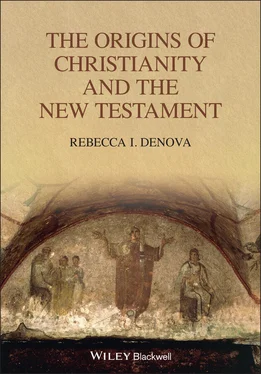Coherence This criterion is also known as that of “consistency.” If a saying of Jesus is already determined to be authentic, the material that “coheres” with the same concept or teaching can then be placed in the “probable” pile.
Dissimilarity This criterion can be somewhat confusing, as it originally had two elements. A centuries-long tradition in Christian theology taught that Jesus came into the world to undo a corrupted Judaism. “Dissimilarity” became the idea that any sayings of Jesus against the “Judaism of his day” therefore must be historical. At the same time, any sayings of Jesus that went against the earliest Christian communities (the “church”) must be part of an earlier, original tradition.This criterion of “dissimilarity” has fallen out of use, as it was based on scholarly nuances and a priori decisions on what was historical and what was not. Instead, it has become part of what is now deemed the criterion of “embarrassment.” For example, Mark reported that when John the Baptist was in the wilderness “baptizing a repentance for the forgiveness of sins,” Jesus came to him and was baptized. Did this mean that Jesus had sinned? No one after Mark repeated this line. According to the criterion of “embarrassment,” there must have been an early and well-known tradition that John had baptized Jesus. Each of the gospels “edits” the story to help explain this tradition. In other words, this story was not likely “created” by the writers.The second quest is also noteworthy for the application of new methods of literary criticism in various approaches to ancient texts (see Box I.1).
Box I.1 Scholarly approaches for the study of the Bible
“Criticism” sometimes implies negative judgment. In this sense, the original Greek concept is utilized. Krino , which means “to discern,” meant discerning the meaning behind the text. The process is known as “exegesis,” a fancy word for “analysis.” In the exegesis of Biblical passages, the analysis goes beyond the “spiritual meaning” of text. It is placed within its historical, cultural, and religious context. It is also useful in analyzing the compositional process of a text.
The different types of criticism are historical criticism (the historical context that gave rise to the passage); form criticism (the original unit before it was edited); literary criticism, in understanding the plot structure and the writer’s point of view; redaction criticism, a fancy phrase for “editing” that traces changes to the text over time; and rhetorical criticism (the art of persuasion or argument). Often several of these approaches are used simultaneously.
Studying the historical context of the “Judaism of Jesus’ day” was enhanced through a major discovery. In 1947, an Arab shepherd boy discovered a jar of scrolls in one of the caves near the ruined site of an ancient community at Qumran on the shores of the Dead Sea. Known as the “ Dead Sea Scrolls,” the manuscripts comprised the library of a sect of Jews understood to be the Essenes.
These Jews were an apocalypticgroup who left Jerusalem c. 150 bce to await God’s final intervention. Initially, the hope was that the scrolls would mention Jesus. They do not, but they provide a window on an apocalyptic group in the first century. The library also contained other contemporary literature that did not make it into either canon (such as the books of Enoch). The Scrolls provide scholars with an overall view of ideas that were “in the air” at the time of Jesus.
A major contribution was the publication of several books by an American scholar, E. P. Sanders. The overarching theme of his work is that New Testament scholars should cease analyzing Jesus as a “Christian” and focus on “Jesus the Jew.” To achieve such an analysis, scholars had to have a full grounding in ancient Judaism first.
Paul and Palestinian Judaism (1977) was a magisterial work that examined the evidence for various Jewish sects as well as the available literature at the time. Sanders uncovered “Paul the Pharisee” and argued against the misconceptions concerning what it meant to be a Pharisee in the first century. More importantly, he analyzed the accusations against the Pharisees in the gospels in light of their rhetorical function. The gospels consistently claim that the Pharisees deliberately kept people from “being saved.” But the concept of “salvation” here is a Christian one; other Jews at the time did not articulate their relationship with God in terms of salvation. Their concern was the Prophetic claim of “restoration” (more on this in Chapter II). In other words, Christians criticized the Pharisees for views they did not hold.
Another major opus was Judaism: Practice and Belief (1992). To be an expert on early Christianity, it is necessary to fully understand the Jewish worldview and how it functioned in their daily lives. In addressing the polemic of the gospels against the Temple in Jerusalem, Sanders outlined the details of Temple worship.
The latest books on the historical Jesus and Paul are sometimes described as the “fourth quest,” in that they introduce more inclusive methodology. An important area of research that is now recognized is the study of texts that did not make it into the canons but are equally important to highlight the views of contemporary Jewish and Christian groups. These texts are categorized under “ pseudepigrapha” or “ apocrypha.” “Pseudepigrapha,” “false writing,” were texts written in the name of a famous or past individual to convey credibility. “Apocrypha” meant “hidden revelations.” Most of these texts concern details of the Prophetic “final days,” such as the books of Enoch.
A full understanding of the gospels and the letters of Paul cannot be complete without an examination of daily life in the cities of the Roman Empire in the first century. Aiding these studies are the most recent archaeological excavations and discoveries. The first Christian communities were established in these cities, where native cults, synagogues, and Christian “house” groups lived in close proximity and interacted.
Arising from the work of E. P. Sanders, a movement known as the “New Perspective on Paul” has produced articles and books on ways in which to read Paul on Paul’s terms, and not the perspective of later Christian theology (especially Martin Luther). At the center of this research is Paul’s relationship to Judaism. These studies are related to post-Holocaust reflections on the ways in which to understand the roots of “ Jewish–Christian relations” in the earliest communities.
Modern scholars apply distinct terminology to analyze religion in the ancient world.
The different phases in the “quest for the historical Jesus” have evolved into analyses that incorporate all aspects of the historical and literary context of the first century.
The list of analytical tools for research continues to be utilized and adjusted.
Suggestions for Further Reading
1 Evans, Craig A. 2012. Jesus and His World: The Archaeological Evidence. Westminster John Knox Press.
2 Evans surveys the archaeological sites that shed light on places and events in the gospels.
3 Levine, Amy Jill, ed. 2006. The Historical Jesus in Context. Princeton University Press.
4 This is a collection of analyses on the way in which preconceived ideas of Jesus influence a historical reading. In this sense, modern scholars have not reached a consensus.
Читать дальше












